
381
Differentiated Services Commands
-------- -------------- -------------- ---------------------
0 10 Weighted Tail Drop
1 10 Weighted Tail Drop
2 10 Weighted Tail Drop
3 10 Weighted Tail Drop
4 10 Weighted Tail Drop
5 10 Weighted Tail Drop
6 10 Weighted Tail Drop
7 10 Weighted Tail Drop
D
IFFERENTIATED
S
ERVICES
C
OMMANDS
This section describes the commands you use to configure QOS Differentiated Services (DiffServ).
You configure DiffServ in several stages by specifying three DiffServ components:
1.
Class
a. Creating and deleting classes.
b. Defining match criteria for a class.
2.
Policy
a. Creating and deleting policies
b. Associating classes with a policy
c. Defining policy statements for a policy/class combination
3.
Service
a. Adding and removing a policy to/from an inbound interface
The DiffServ class defines the packet filtering criteria. The attributes of a DiffServ policy define the way the switch processes
packets. You can define policy attributes on a per-class instance basis. The switch applies these attributes when a match
occurs.
Packet processing begins when the switch tests the match criteria for a packet. The switch applies a policy to a packet when
it finds a class match within that policy.
The following rules apply when you create a DiffServ class:
•
Each class can contain a maximum of one referenced (nested) class
•
Class definitions do not support hierarchical service policies
A given class definition can contain a maximum of one reference to another class. You can combine the reference with other
match criteria. The referenced class is truly a reference and not a copy since additions to a referenced class affect all classes
that reference it. Changes to any class definition currently referenced by any other class must result in valid class definitions
for all derived classes, otherwise the switch rejects the change. You can remove a class reference from a class definition.
The only way to remove an individual match criterion from an existing class definition is to delete the class and re-create it.
Note:
The mark possibilities for policing include CoS, IP DSCP, and IP Precedence. While the latter two are only
meaningful for IP packet types, CoS marking is allowed for both IP and non-IP packets, since it updates the
802.1p user priority field contained in the VLAN tag of the layer 2 packet header.
Summary of Contents for DWS-4000 Series
Page 20: ...D Link Unified Switch CLI Command Reference 12 2009 D Link Corporation All Rights Reserved ...
Page 170: ...D Link Unified Switch CLI Command Reference 162 2009 D Link Corporation All Rights Reserved ...
Page 369: ...361 Captive Portal Status Commands Locale Link The names of the languages Field Description ...
Page 416: ...D Link Unified Switch CLI Command Reference 408 2009 D Link Corporation All Rights Reserved ...
Page 528: ...D Link Unified Switch CLI Command Reference 520 2009 D Link Corporation All Rights Reserved ...
Page 545: ...537 O SSupport ...
Page 546: ...D Link Unified Switch CLI Command Reference 538 2009 D Link Corporation All Rights Reserved ...
Page 566: ...D Link Unified Switch CLI Command Reference 558 2009 D Link Corporation All Rights Reserved ...
















































